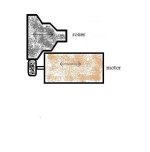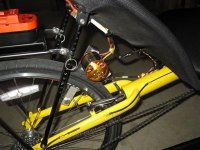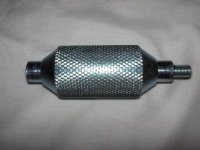I set up a test of an assembly that would be like one in a multispeed friction drive. However, it only had one speed since I'm not a talented fabricator. It showed promise, though it was a bit flimsy to hold up to a lot of adjustment attempts. Instead of restrengthening it and continuing to work with it, I have decided to concentrate on moving the concept forward with some new ideas.
I looked into the possibility of a freewheeling roller assembly based around something like a standard single sprocket freewheel with a #25 sprocket or belt cog pulley piggy-backed onto it. Such a standard-type hub freewheel is really overly heavy duty for friction drive application since it is designed to handle forces at a 26:1 mechanical disadvantage over what is needed to drive the wheel at the periphery (26 inch wheel). That makes it too noisy at high rpms produced at the tire, and its rolling resistance is excessive on account of the stiff paw engagement. That second drawback might not really matter much in reality, though.
Since the rotation rate is higher by a factor of 26 while the torque is lower by the same factor, the material of the assembly need not be metal (except maybe aluminum), but rather, plastic should work well. That gives a big weight reduction bonus, plus it's much easier to machine. The roller's contact area with the tire is covered with grip tape or other protective material, so it doesn't matter that much that it is plastic.
The freewheel being at the roller is better than on the motor since then the motor and chain can be still if the system isn't being powered. This aspect is important at the high speed at the wheel periphery. On the test version I recently tried out, the plastic chain always turned so long as the roller was engaged with the tire, so it was not the recommended way to do it.
The freewheel would be able to slide on splines on the plastic multispeed roller so that when the roller is forced left or right, the motor and drive belt (or plastic chain) can retain a single position. If dirt might be a problem, the plastic freewheel/roller assembly might still be a good choice even for a single speed rendition of the concept. Then, the assembly would be simpler and narrower, without spline tracks and a sled-axle to get dirty or jammed.
I see really big potential for friction drive, based on the recent test I did as well as all the swell projects that fellow ES members have done.
Edit: I forgot about an important consideration with shifting gearing on a multispeed assembly. When the drive wheel is moved left or right to change the drive ratio, the motor would have to move closer or farther from the drive wheel as the axis of the roller shifts in or out a little. However, if the in and out movement of the roller is around an axis that aligns with the motor axis, the belt or chain length will not want to increase or decrease, the distance between the pulley or sprocket centers will remain relatively constant.











